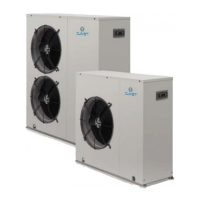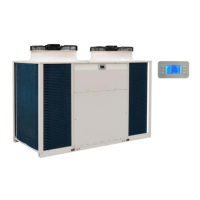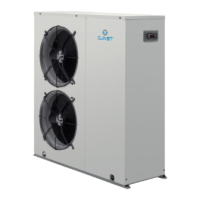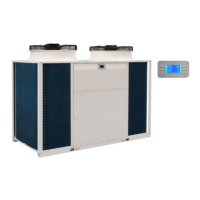Do you have a question about the CLIVET WSAN-XIN 40.2 and is the answer not in the manual?
Highlights potential risks and the need for qualified personnel for safe operation.
Instructs to disable the unit immediately and contact a certified service agent.
Provides detailed steps for safe handling and lifting of the unit.
Covers external installation, fixed positions, and placement criteria for optimal operation.
Details water quality requirements and potential issues affecting the unit.
Specifies the required water flow-rate for proper exchanger operation.
Provides steps for making the necessary hydraulic connections.
Explains the function and installation of the flow switch for safety.
Step-by-step procedure for the hydraulic circuit's operation and filling.
Provides essential steps for making electrical connections safely.
Guides on connecting and configuring a PC for unit monitoring and control.
Details Modbus/RS485 communication setup and cable requirements.
Covers LonWorks communication setup and cable specifications.
Explains BACnet IP communication setup and configuration.
Lists essential pre-operation checks before and after power cycling.
Details the step-by-step procedure for powering up the unit.
Checks for oil leaks, pressure, and valve status in the refrigeration circuit.
Ensures the water circuit is clean, filled, pressurized, and free of air.
Verifies grounding, connections, voltage, and phase balance of the electrical circuit.
Describes the ECOSHARE function for managing multiple units in a network.
Checks water flow-rate against formula and pressure drop graphs.
Discusses compressor rotation direction and thermal protection.
Warns about damages from prolonged reduced load operation and frequent starts.
Details how to adjust setpoints for cooling, heating, and domestic hot water.
Instructions for setting weekly operating events and enabling the scheduler.
Procedures for identifying, removing causes, and resetting alarms.
Comprehensive list of electrical, refrigerant, and hydraulic alarms.
Details inspection frequency and tasks based on usage and component checks.
Stresses the importance of keeping the water side exchanger clean for maximum thermal exchange.
Explains the advanced scroll compressor temperature protection mechanism.
Procedures for safe disconnection and recovery of refrigerant and solutions.
Risks from electrical connections, covers, earthing, and voltage exposure.
Risks related to refrigerant expulsion, heating, and potential explosions.
Highlights potential risks and the need for qualified personnel for safe operation.
Instructs to disable the unit immediately and contact a certified service agent.
Provides detailed steps for safe handling and lifting of the unit.
Covers external installation, fixed positions, and placement criteria for optimal operation.
Details water quality requirements and potential issues affecting the unit.
Specifies the required water flow-rate for proper exchanger operation.
Provides steps for making the necessary hydraulic connections.
Explains the function and installation of the flow switch for safety.
Step-by-step procedure for the hydraulic circuit's operation and filling.
Provides essential steps for making electrical connections safely.
Guides on connecting and configuring a PC for unit monitoring and control.
Details Modbus/RS485 communication setup and cable requirements.
Covers LonWorks communication setup and cable specifications.
Explains BACnet IP communication setup and configuration.
Lists essential pre-operation checks before and after power cycling.
Details the step-by-step procedure for powering up the unit.
Checks for oil leaks, pressure, and valve status in the refrigeration circuit.
Ensures the water circuit is clean, filled, pressurized, and free of air.
Verifies grounding, connections, voltage, and phase balance of the electrical circuit.
Describes the ECOSHARE function for managing multiple units in a network.
Checks water flow-rate against formula and pressure drop graphs.
Discusses compressor rotation direction and thermal protection.
Warns about damages from prolonged reduced load operation and frequent starts.
Details how to adjust setpoints for cooling, heating, and domestic hot water.
Instructions for setting weekly operating events and enabling the scheduler.
Procedures for identifying, removing causes, and resetting alarms.
Comprehensive list of electrical, refrigerant, and hydraulic alarms.
Details inspection frequency and tasks based on usage and component checks.
Stresses the importance of keeping the water side exchanger clean for maximum thermal exchange.
Explains the advanced scroll compressor temperature protection mechanism.
Procedures for safe disconnection and recovery of refrigerant and solutions.
Risks from electrical connections, covers, earthing, and voltage exposure.
Risks related to refrigerant expulsion, heating, and potential explosions.
| Model | WSAN-XIN 40.2 |
|---|---|
| Category | Heat Pump |
| Cooling Capacity | 40.2 kW |
| Power Supply | 400V / 3Ph / 50Hz |
| Refrigerant | R410A |











